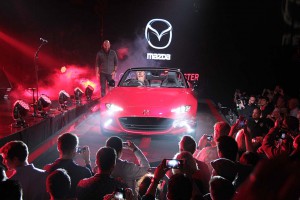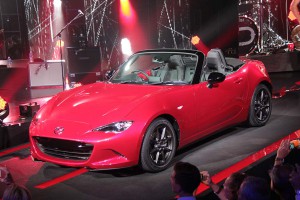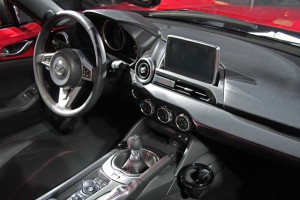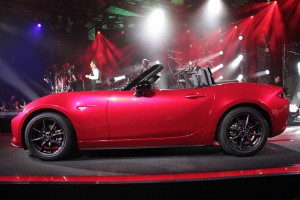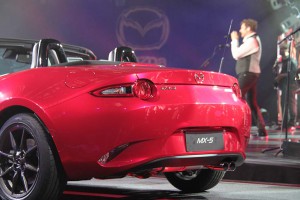When it first rolled out a quarter century ago, the original Mazda Miata delivered the sort of shock the auto industry needed, a sleek, small roadster that reminded us that cars didn’t have to be bland, boring and utilitarian.
Though sales have slowly dwindled in recent years, the MX-5 Miata has remained an icon for the Japanese brand, so Mazda clearly knew it was taking some serious risks when it set out to redesign the 2-seater, all the more so when it agreed to enter into a joint venture with Italy’s Fiat.
“There was a lot of pressure to do a great car,” recalled Mazda Design Director Derek Jenkins, admitting there were times when he worried “I hope we don’t screw this up.”
Miata fans can now finally judge for themselves, Mazda pulling the wraps off the 2016 MX-5 Miata during a global preview that featured simultaneous unveilings in Monterey, California, Barcelona, Spain and back home in Japan.
The original MX-5 delivered a careful balance of performance, dynamics, design and affordability, and those were factors Jenkins design team had to keep in mind as they set out to develop the most significant remake of Miata since its 1989 debut.
“Go too modern, too radical and we’d risk alienating our core audience,” he said during the unveiling. But, “If we didn’t do enough, we’d risk not reaching a new audience.”
The results of Mazda’s efforts clearly walk that fine line. Curiously, there are a few subtle details, such as the “blade” taillights that might bring to mind the much more expensive Jaguar F-Type, the new Mazda roadster is unmistakably a roadster, albeit with a much more luxurious and modern feel.
(An all-new Mazda2 breaks cover. Click Here for a closer look.)
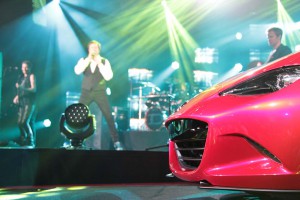
Classic rock band Duran Duran turned out for the Miata debut - which also drew 100s of loyal owners.
The car appears to be crouching down with what Jenkins calls “an impossibly low hood.” The face of the new Miata bears the influence of the Mazda Kodo concept vehicle, but the slim new LED headlamps – which will be standard on all versions – actually pick up the shape of the original car’s pop-up lamps.
Unlike other recent Mazda models, such as the Mazda5 people-mover, the new Miata shows significant styling restraint, with body sides that skip the heavy doses of chrome and sheet metal sculpting. There’s just a subtle “hip line” that flows into the muscular rear haunches that give the new car a sense of barely restrained power.
Unfortunately, what sort of power it will deliver is a question unanswered, the Tuesday night previews focused solely on design issues. We do know that the 2-seater will adopt of Mazda’s new SkyActiv powertrain technology. The word among Miata’s loyal fan base point to the 2.0-liter SkyActiv-G making 155-horsepower and 150 pound-feet of torque, though some reports have suggested Mazda could have another powertrain option in the works, as well.
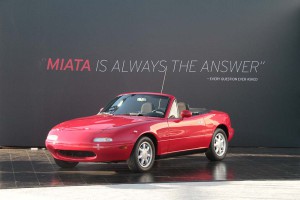
One reviewer called the original Mazda Miata "the best British sports car the Japanese have ever made."
Even if it delivered the same power as today’s 2-seater, we’d expect a knock-up in performance. Jenkins notes that the lower and slightly wider Miata will have improved aerodynamics – though he stresses that reducing drag was just one target, along with improving downforce and reducing lift.
Meanwhile, Mazda’s increasing emphasis on what industry types call “lightweighting” has apparently paid off handsomely. According to spokesman Jeremy Barnes, the 2016 MX-5 will shed about 100 kilograms, or 220 pounds, compared to the current, 2,480-lb roadster. A quick bit of math would bring that in around 2,260 lbs for the average model.
Expect other technical improvements that will likely improve performance, as well as handling – though Mazda is carefully orchestrating the roll-out of the new Miata and will drop details in a serious of follow-up news events.
(Aston Martin’s new Vantage S Roadster roars into view. Click Here for a closer look.)
The development of the new car was “a global effort,” emphasized Jenkins, pointing to Mazda’s designers in the U.S., Europe and Japan. What he left out was the role played by Fiat – which originally intended to sell its version of the roadster through the Alfa Romeo brand. Earlier this year, however, CEO Sergio Marchionne let slip that Alfa’s changing product strategy no longer had room for the little convertible, and that it would now be marketed through the parent Fiat brand.
Jenkins said there were no significant hurdles created by having to work together with Fiat. In fact, many of the key, collaborative efforts apparently took place before Mazda’s design team got to work, engineers from both companies early on agreeing on the so-called “hard points” upon which they would hang the sheet metal.
During the unveiling, Jenkins did make several references to the introduction of substantial new technology with the new MX-5 Miata. In particular, he hinted there would be a high-tech solution to improving the car’s pedestrian protection – no easy task considering that “impossibly low hood.” Might a pyrotechnic system – using airbag like inflators to raise the hood and give more crumple space – be in order?
Occupants will likely receive some new safety hardware, as well. And a glimpse of the prototype Miata’s interior reveals the roadster will now be equipped with a new 7-inch touchscreen display – with backup controller – to operate its infotainment system.
The cabin, according to Jenkins, loses no space and actually features more flexible seating. The instrument panel has a classic feel – beyond the videoscreen – with a definite driver focus. There are three gauge clusters and traditional round air vents. Overall, the two prototypes on display revealed a much more elegant use of materials, along with more sophisticated fit and finish, than the utilitarians Miata cabins of the past.
(Convertible owners more educated, affluent, finds new study. Click Here to find out more.)
Among the many unanswered questions, Mazda has yet to say when we’ll actually see the 2016 MX-5 Miata roll into showrooms. Logic would seem to suggest sometime before the traditional convertible season next spring, but spokesman Barnes would only go as far as saying sales will begin “sometime in 2015.”
The final big unknown is pricing. There’s a lot of content in the new 2016 Mazda MX-5 Miata that would suggest a sizable bump upwards in MSRP. But the little roadster’s appeal has been based, in part, on affordability, so Mazda would risk alienating both traditionalists and future buyers if it tried to stretch too far. We hope to fill in all these blanks in the next few months.

